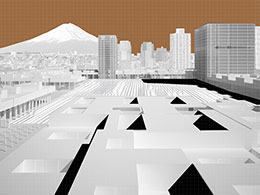STUDENTS PROJECTS
PROJECTS2015
Student: Oikonomou Florentia
Supervisors: Dimitra Katsota, Nikos Smirlis
Architecture Department of Patras
Presentation date: 26/06/2015
The fifth housing generation in Tokyo redefines a superblock in Shinjuku. The empty space and the ground floor exist again. Without any connection of the residences there are no longer neighbors: UN - neighbor. Considering the life cycle of a building which is twenty-six years this strategy is going to be complete in 2072 in all the Tokyo.

The city of Tokyo in 2015 has been defined by the four generations[1] of private residences. The interpretation of generations in housing originates from the research of the Atelier Bow-Wow and their project of Tokyo Metabolizing[2] for the Japanese Pavilion of 2010 Venice Biennale. The project UNneighbor is an aspect of the fifth housing generation in Tokyo, which integrates the Urban scale of a superblock[3] in the area of Shinjuku.
The existing situation of this superblock represents the basic model of a housing area in Tokyo. Based on the analysis of the project Tokyo Metabolizing but also by the specific superblock we realize the existence of a figure called "firewall"[4]. Generally, in a housing block in Tokyo and also in the specific superblock in Shinjuku, there is an unregulated allocation of houses and the roads in the center, the firewall in the periphery and the basic roads around the block. The idea of the project UNneighbor is basically to move the encircled residences to the periphery, by redefining a new wall of housing and creating a new gab in the center of the block. The houses raised to a new level, above the ground, creating a free space underneath in order to place other facilities apart from housing areas, which already exists in the current block structure. The residences are united without any connection between them in the horizontal axis, in contrast from the vertical axis, which is creating a new type of neighbor. Every single resident has its own patio reinforcing the privacy of the house.
The project is separated in four different layers. The first one is called "the mat" which is referring to the empty space in the center of the block. Three types of cultivations are placed in the gab. In the first area, in the center, there is a tea cultivation, in the second area at the entrances there is the Wisteria Tree and the third area is a Gingko Tree park. Also, the second layer of the project is called "the pilot" which includes all the facilities except from the housing area and is created by the large number of residence's pillars. The specific area is also separated in five sections of commercial, healthcare, education, cultural and sports. There are also intermediaries parking areas because of the necessity of parking spaces in city. Continuing to the most important layer of the project is "the housing". There are five type of houses including all the different variations of their expansions. Finally, the last layer of the project is "the connection" which is the horizontal movement to and from the residences, starting from the ground to the upper level. There are horizontal corridors which lead on the private stairs-entrances of the houses.
The title UNneighbor has been given because of the creation of a new neighborhood where basically there is not any essential connection between the inhabitants. The lack of external windows, as opposed to inward facing patio, creates the condition of a neighborhood which neighbors cannot see each other from the inside of their houses. Nevertheless, there is a coexistence and a connection between the habitants through the empty spaces inside the block, the ground floor and the intermediate level of the movement.
This project is a proposal for all the housing areas of Tokyo. Figuring the four house generations in houses and their life cycle of the twenty-six years, starting from the Tokyo of 2020 the alteration of the city can be completed in 2072 in a redefined Urban Design.









[1] In 1920 the suburbia of Tokyo had been established by the "modern" movement of housing, which is existing until today. The lifetime of this houses is approximately twenty-six years, so since 1923 there have been rebuilt at least two to four times - four generations. Chronological: 1923-1949-1975-2001.
[2] In 2010 the 12th Venice Biennale of architecture coincides the fifty years' anniversary of the Metabolism movement in Japan. The book Tokyo Metabolizing has been published for the Japanese Pavilion in Biennale. The authors are the architects Koh Kitayama, Yoshiharu Tsukamoto and Ryue Nishizawa. This book is redefining a new type of metabolize for the city of Tokyo, based on the manifesto of the Metabolisms movement in 1960. (1 / 2: Kitayama Koh / Tsukamoto Yoshiharu / Nishizawa Ryue [2010], Tokyo Metabolizing, Japan: ΤΟΤΟ)
[3] Superblock: a building block in Tokyo with huge dimensions
[4] Many old residential areas in Tokyo still have wooden flat buildings. In the case of big earthquake, those areas easily start burning and the fire can spread widely. In order to prevent spreading fire, big streets dividing those areas are given a role to react as a firewall. (Yoshiharu Tsukamoto [2007] "Atelier Bow-Wow: Tokyo Anatomy", online magazine: Archinect)











